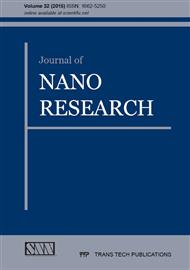p.32
p.43
p.51
p.60
p.66
p.71
p.81
p.93
p.106
Copper Quantum Dots Formation in a Borosilicate Glass
Abstract:
This Borosilicate glass offers superior properties to the ordinary silicate glass. Metallic quantum dots embedded in glass are promising materials which can be used in modern optical devices. However, the introduction of metallic quantum dots into borosilicate glass has not been studied. We investigated the formation of copper quantum dots in Cu-doped borosilicate glass matrix using thermal annealing process. The reductant SnO included in borosilicate glass played an important role in the formation of the metallic quantum dots. Specifically, Cu quantum dots were formed only when SnO content reached at least 0.5 wt% after borosilicate glass was heated at 600 °C for 60min, which was evidenced by the detection of the characteristic absorption band at about 560nm originated from the surface plasmon resonance of Cu nanoparticles. The optimal concentration of SnO was found to be 1.5 wt% and the mean size for the heating-induced Cu quantum dots was calculated to be ~1.7 nm. Our data offer a simple approach to prepare the metallic quantum dots in borosilicate glass matrix and suggest a new type of metallic quantum dots for applications where superior durability, chemical and heat resistance are required.
Info:
Periodical:
Pages:
66-70
Citation:
Online since:
May 2015
Authors:
Keywords:
Price:
Сopyright:
© 2015 Trans Tech Publications Ltd. All Rights Reserved
Share:
Citation:


